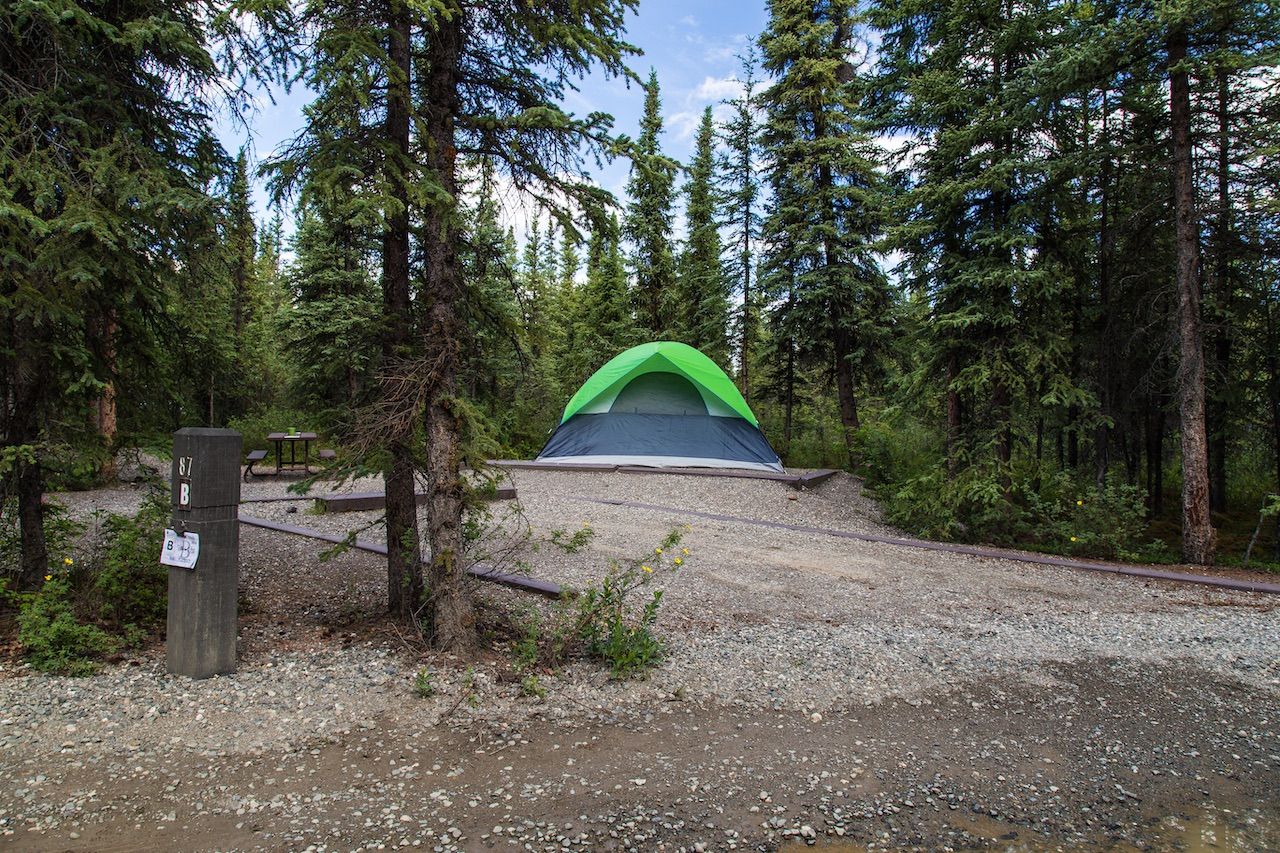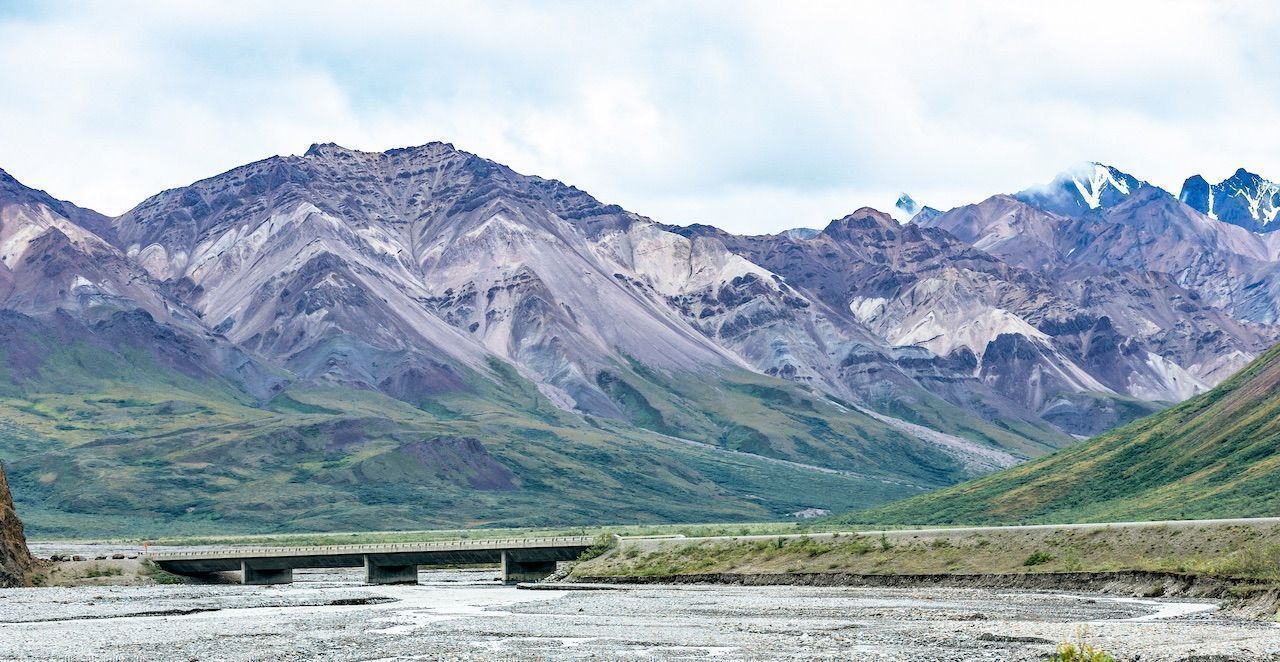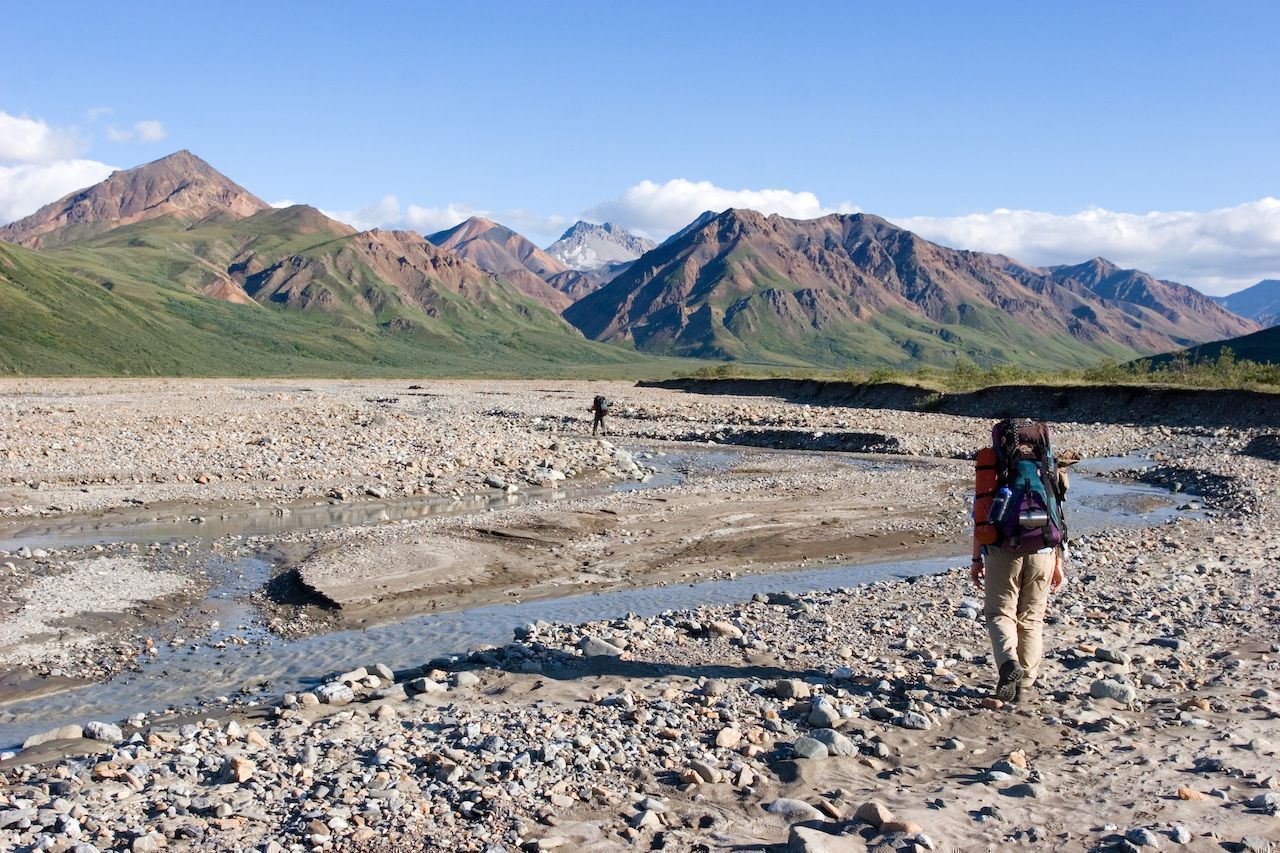Denali National Park has six campgrounds, ranging from mile 0.4 to mile 85. The main benefit of camping within park boundaries is the amenities. Most have wilderness-style restroom facilities, and some even have potable water, charging stations, and fire pits to warm yourself by. If traveling by RV, be sure to book a campground noted as RV-friendly. Tent campers have it easy — you can lounge in style at any campground in the park. In addition to official campsites, Denali also offers plenty of wild backcountry to park your tent. Here, we tell you what you need to know to sleep under the stars in Denali.

Photo: National Parked/Shutterstock
Riley Creek Campground — Located at mile 0.4, Riley Creek sits at the park’s entrance. It has flush toilets, showers, and potable water come summer. There are 147 RV/tent sites, 20 tent-only sites, and one group (tent) site. It’s open year-round, but fees apply only in summer, ranging from $15/night for tents and $24-30 for RVs to $46/night for groups. Reservations for this and other reservable campgrounds can be made online at Reserve Denali or by calling 1(800) 622-7275 in the US or 1(907) 272-7275 internationally. Reservations can be made for the next year as early as December 1st.
Although it’s fairly wooded, Riley Creek sits close to Highway 3. That has both advantages and disadvantages. While it’s easily accessible, you may hear some highway noise. You’ll also have access to businesses outside the park and the park entrance area, where the main facilities and the central trail system can be found. (Note that Riley Creek is called Tsenesdghaas Na’ in the Ahtna dialect, meaning “Rough Rock Creek.”)

Photo: Michelle Holihan/Shutterstock
Savage River Campground — At mile 13, Savage River sits in a spruce forest, near views of Denali. It’s open from May 20 to September 18. It has 32 RV/tent sites and three group (tent) sites, along with flush toilets, vault toilets, and potable water. Fees are $24/night for tents, $24-30 for RVs, and $46/night for groups. Before driving to Savage River, stop at Riley Creek Mercantile at the entrance of the park to purchase necessities like firewood. (Saveage River is called Tr’at’egheth No’ in the Lower Tanana dialect, which means “From Cottonwood Creek.”)

Photo: Tom Tietz/Shutterstock
Sanctuary River Campground — Sanctuary River, at mile 22.6, is the first campground out of reach of personal vehicles; access can only be had via the park shuttle bus. With an uphill hike, you’ll find views of Denali to the south. This small campground is open from May 20 to September 7. There are seven tent-only sites (no vehicles allowed) and vault toilets; there is no potable water. Fees are $15/night. Note: Advanced reservations are not possible for Sanctuary River; sites are first-come, first-served.

Photo: Ovidiu Hrubaru/Shutterstock
Teklanika River Campground — Reached at mile 29, Teklanika sits at the foot of Cathedral Mountain and, as the name suggests, the Teklanika River. The campground is open from May 20 to September 12. There are 53 RV/tent sites reservable for $25/night; there are vault toilets and potable water. Note: Campers at Teklanika River are allowed a personal vehicle with stays of three nights or more. You may only drive the vehicle upon your entrance and exit. (Teklanika River, known as Toch’edha Nik’a in the Lower Tanana dialect, means “Water Amulet River.”)
Igloo Creek Campground — You’ll find Igloo Creek, near Igloo Mountain, at mile 34. It’s a tiny, isolated campsite one-third of the way into the park. The campground is open from May 20 to September 12. There are seven tent-only sites and vault toilets; there is no potable water. Fees are $15/night. Access is only via the park shuttle bus. Note: Advanced reservations are not possible for Igloo Creek. Sites are first-come, first-served.

Photo: Michelle Holihan/Shutterstock
Wonder Lake Campground — Wonder Lake is by far the deepest in the park, all the way in at mile 85. Though Denali is still 26 miles away, it hangs over the grounds on clear days. The campground is open from June 8 to September 12. It has 28 tent-only sites, flush toilets, and potable water. Fees are $16/night, with a $6 one-time reservation fee. Access is only via the park shuttle bus.

Photo: inEthos Design/Shutterstock
Denali is a six-million-acre wilderness made up of five terrain types: gravel river bars, wet tundra, dry tundra, brushy tundra, and glacial moraines. Going on your own is a serious responsibility. If you’re up to the challenge, here’s the protocol:
- Plan ahead. Denali is made up of 87 units of backcountry space, 41 of which have quotas. Research the units and have a plan A, B, and C. (Keep in mind that the closer your unit is to the entrance, the shorter the bus ride.) You may not get your first-choice unit, and that’s fine. The entire park holds adventure.
- Arrive at the Denali Visitor Center when it opens (8:00 AM in summer). Permits are granted on a first-come, first-served basis either on the day of or the day before your trip.
- You must have a backcountry permit before purchasing a camper bus ticket. After you obtain your permit, arrange transportation for pick-up at the end of your trip.
- Watch the orientation video. This is both for your safety and for the protection of the park.
- Purchase all items and supplies you need either outside the park or at Riley Creek Mercantile before venturing into the backcountry. To avoid carrying all your food at once, cache your supplies in the food lockers at any campground, the Eielson Visitor Center, or the Toklat rest stop. The park does lend out bear-resistant food containers for free.
- And for a complete backpacking gear list, check out Matador’s guide.

Photo: Bryan Brazil/Shutterstock
If you’ve never backpacked off-trail before, consider units 1, 9-13, 18, 34, and 42.
Units 1-5 and 24-27 are within that magical first 15 miles of the park road, meaning you’ll have access to the free Savage River Shuttle, and you can use your car. If you’re looking for long day hikes, easier backpacking trips, or to avoid a long bus ride, beeline to these units. Overnight parking can be found at the Riley Creek Day-Use Area and at the Denali Visitor Center.
For easy-to-navigate valleys and gravel river bars, look to the units south of the park road (6-10, 12, and 13). You’ll be hiking toward the Alaska Range. Because of this, these are the more popular units, particularly 12 and 13. Prepare for the occasional human and water crossing.
If you’re looking for high ridges and spectacular views, check out units 25-30, 33-34, and the Kantishna region. Warning: Travel will be slow and brushy. From far away, brush can look ankle-high and harmless; up-close, you’ll wish you had a machete.
For super remote areas, look to units 21, 38-40, 44, and 87. If you’re a beginner, cross these off your list.
For valley glaciers, look to units 23, 44, and 87.